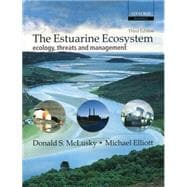
Note: Supplemental materials are not guaranteed with Rental or Used book purchases.
Purchase Benefits
What is included with this book?
| The Estuarine Environment | |
| Life in Estuaries | |
| Primary Producers: plant production and its availability | |
| Primary Consumers: herbivores and detritivores | |
| The Secondary Consumers: carnivores | |
| Estuarine Uses and Users | |
| Methods for Studying Human-Induced Changes in Estuaries | |
| The Management of Estuaries | |
| Table of Contents provided by Publisher. All Rights Reserved. |
The New copy of this book will include any supplemental materials advertised. Please check the title of the book to determine if it should include any access cards, study guides, lab manuals, CDs, etc.
The Used, Rental and eBook copies of this book are not guaranteed to include any supplemental materials. Typically, only the book itself is included. This is true even if the title states it includes any access cards, study guides, lab manuals, CDs, etc.